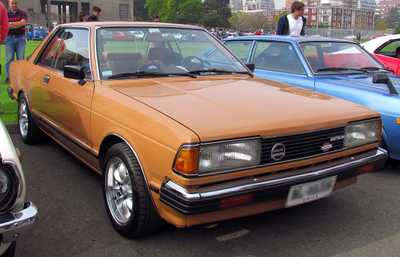1979 - 1993
The Nissan Bluebird 910, produced by the renowned Japanese automotive manufacturer Nissan, was a car model generation that left an everlasting impression on the automotive industr...
Coupe
1.8 MT (105 hp)
1.8 MT (89 hp)
1.8 SSS MT (115 hp)
1.8 T SSS MT (133 hp)
Hardtop
1.8 MT (87 hp)
1.8 SSS MT (115 hp)
1.8 T MT (137 hp)
Sedan
1.6 MT (96 hp)
1.8 MT (105 hp)
1.8 MT (87 hp)
1.8 SSS MT (115 hp)
1.8 T MT (137 hp)
Wagon
1.6 MT (96 hp)
1.8 MT (105 hp)
1.8 MT (87 hp)
1.8 SSS MT (115 hp)
| Name | Value | Unit |
|---|---|---|
| Acceleration (0-100 km/h) | 14.3 | s |
| Back suspension | Independent, spring | |
| Body type | Coupe | |
| Capacity | 1770 | cm3 |
| City driving fuel consumption per 100 km | 11.5 | l |
| Cruising range | from 540 to 650 | km |
| Curb weight | 1026 | kg |
| Cylinder bore | 85 | mm |
| Cylinder layout | Inline | |
| Drive wheels | Rear wheel drive | |
| Engine power | 105 | hp |
| Engine type | Gasoline | |
| Front brakes | drum | |
| Front suspension | Independent, McPherson Struts, spring, Stabilizer bar | |
| Front track | 1371 | mm |
| Fuel | 92 | |
| Fuel tank capacity | 62 | l |
| Gearbox type | Manual | |
| Ground clearance | 160 | mm |
| Height | 1385 | mm |
| Highway driving fuel consumption per 100 km | 9.5 | l |
| Injection type | carburetor | |
| Length | 4360 | mm |
| Maximum torque | 146 | N*m |
| Max power at RPM | to 6 000 | RPM |
| Max speed | 170 | km/h |
| Mixed driving fuel consumption per 100 km | 10.5 | l |
| Number of cylinders | 4 | |
| Number of gear | 4 | |
| Number of seater | 5 | |
| Presence of intercooler | Present | |
| Rear brakes | drum | |
| Rear track | 1360 | mm |
| Stroke cycle | 78 | mm |
| Turning circle | 11 | m |
| Turnover of maximum torque | to 3 600 | RPM |
| Valves per cylinder | 2 | |
| Wheelbase | 2525 | mm |
| Width | 1655 | mm |

